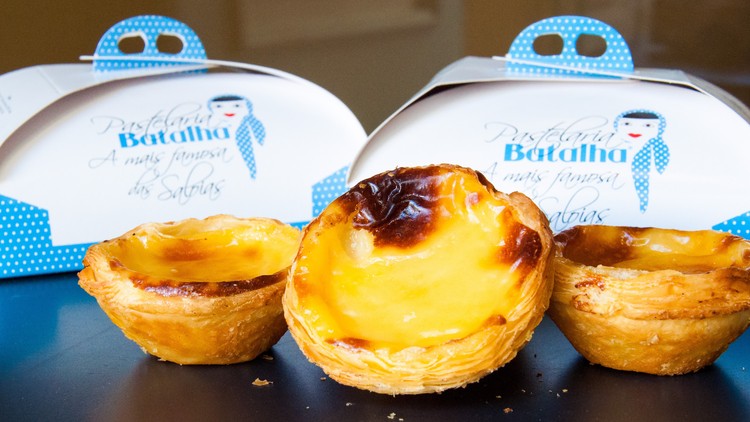PASTEL DE NATA - Portuguese custard tarts for all levels!
- Description
- Curriculum
- FAQ
- Reviews
- Grade

Pastel de Nata is Portugal’s most famous sweet treat. Known as Pastéis de Belém in the Portuguese speaking world, Egg Tart (dàntǎ) in Asia and Custard Tarts in many parts of the world, these flaky pastry treats are filled with smooth custard, and it’s hard to eat just one at a time. Following this course, you will understand what makes authentic Pastel de Nata different from variations of custard tarts or even egg tarts you might have tried outside Portugal.
*** Course videos are in English but include subtitles and recipes for download in English, Spanish, Portuguese, French, German, Italian, Korean, Arabic, Chinese Mandarin, Japanese and Russian. ***
We will cover all the steps in an easy to follow way, and I will show you the tricks to make your pastries as professional as those you’d find in pastry shops all over my country. We have tips for the dough and also little twists for the custard, to balance flavors and textures beautifully.
If you have tasted Pastel de Nata at a Portuguese bakery and you’d love to make some at home, this course will show you how to accomplish that. If you are a professional baker perhaps looking forward to serve genuine custard tarts in your establishment, you can also gather a lot of pro tips following this course! Obrigado! 🙂
-
3Basic Dough: with mixer and by hand
Pastel de Nata making starts similarly to a bread or pizza recipe! But, in this case, we will start the recipe making a "dead dough", that is, a dough without yeast that is not meant to rise. This is the base dough which we will eventually turn into puff pastry. If you have a dough mixer at home, I will show you how to make the most of it to achieve this part of the recipe. If you don't have a mixer, don't worry! I also show how to do it all by hand, which is actually more fun for those who literally like getting their hands "dirty"!
-
4Puff Pastry: upgrading the dough to layered pastry
Puff pastry can be intimidating, even for home-bakers who may be experienced with other types of cooking techniques. Fear not! When you break it down step by step, puff pastry is fairly simple and actually fun to make.
After showing you how to make the dough, we will go into how to upgrade that dough into flaky puff pastry. In Portugal it is customary to use vegetable margarine for puff pastry, and many other cakes too. But this is no ordinary margarine! It's margarine specific for puff pastry, pastel de nata and croissant, which is locally known as margarina para folhados. It doesn't get burnt even at very high temperatures, which is super important as Pastel de Nata is baked at a high temperature so that it caramelizes as it should. Please don't use regular store bought margarine for this, the one you'd spread on toast, as the results won't be the same. If you can't get puff pastry level margarine (normally sold in establishments for the F&B industry or baking supply stores), I'd recommend using butter instead. While this recipe calls for 250 grams (8.8 oz) of margarine, the amount if using butter would be 180 grams (6.3 oz) - margarine and butter have different consistency and water content, as such, the amounts used would be different!
-
6How to prepare molds for first time use
If you truly want to achieve authentic looking and tasting Pastel de Nata, I urge you to get some pastry molds specific for this Portuguese pastry.
These are the standard measurements of Pastel de Nata tins:
Base: 3,5cm | 1.4 inches
Top part: 7cm | 2.7 inches
Height: 3cm | 1.2 inches
Genuine Pastel de Nata molds are inexpensive and fairly easy to source - ask me for advice and I can help you figure this out, depending where you are in the world.
In this lecture, I show you how to season your Pastel de Nata molds before their very first use. This is an important step to ensure your molds are ready to be used for a long, long time. This process guarantees perfect baking in these non-stick tins, while also optimizing the molds for your own safety.
-
7Shaping dough and finishing touches on custard
When you go out and eat a Pastel de Nata, you can do a simple test for the quality of its crust: lift the pastry and inspect the bottom. The puff pastry laminations should appear as a spiral - this clearly shows that the baker knew the right technique for Pastel de Nata. During this lecture, I show you how to spread the puff pastry on the Pastel de Nata molds in this signature way, for maximum flakiness and crispy results. We also go over the last finishing touches for the custard and how to assemble your pastries before they finally go into the oven.
-
8Baking!
Pastel de Nata is baked at very high temperatures, allowing for the top layer of the custard to caramelize, while the puff pastry around it gets beautifully golden. Many people, even here in Portugal, think home ovens won't be good enough for this, but this is actually not true! I teach you how to use your home oven to bake perfect pastries. But because all ovens are different, it wouldn't be enough to say how many minutes you have to bake your pastries for. Instead, I show you how to know when they are done!












